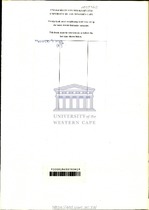| dc.contributor.advisor | van der Horst, G. | |
| dc.contributor.author | Woodroof, Colin William | |
| dc.date.accessioned | 2021-09-30T11:34:54Z | |
| dc.date.available | 2021-09-30T11:34:54Z | |
| dc.date.issued | 1993 | |
| dc.identifier.uri | http://hdl.handle.net/11394/8489 | |
| dc.description | Masters of Science | en_US |
| dc.description.abstract | There is a need for defined models of human nutritional disorders partly because serious misconceptions about models are common amongst researchers. Historically a large variety of species has been used including primates, pigs, rats, lagomorphs. Advantages various small carnivores and and disadvantages are not well known and availability is a major factor. In 1753 John Hunter used pigs to study bone growth in one of the first scientifically controlled nutrition experiments (Kobler 1960). Rats were most likely the first animals to be bred specifically for scientific purposes and there is evidence that they were used in nutrition experiments during the late eighteenth century
(Kobler 1960). Experience with carcinogenesis in animals has shown the great diversity of results which may possibly be obtained from different species (Lave et al. 1988). This is pertinent to nutritional research as there is an established link between diet and cancer. The selection of a suitable substitute to attempt to model possible human response to a variety of procedures is dependent upon criteria among which the following are possibly the more important. Availability; this is of great importance in Southern Africa where the cost of importation of exotic species. must be taken into account. Du Plessis (1981) referred to the fact that our indigenous primates were a valuable resource.
A second consideration must be the cost the selected animal in a scientifically acceptable environment. Keeping animals of maintaining and ethically for research purposes in an uncontrolled environment could well lead to erroneous conclusions being made. Thirdly the cost of a research program in which animals are used may be increased if there is insufficient knowledge of the model selected. A paucity of knowledge available about an animal may affect the viability of an experiment. The need for precise information regarding the effects of extended term dietary supplementation of experimental animals has been noted by Fincham et. al. (1987) . Additionally the selected animal should preferably have similar dietary requirements to man, and have a life span which will enable extended term investigations. | en_US |
| dc.language.iso | en | en_US |
| dc.publisher | University of the Western Cape | en_US |
| dc.subject | N-acytylgalactosamine | en_US |
| dc.subject | Callithrix Jacchus | en_US |
| dc.subject | Muscularis externa | en_US |
| dc.subject | Lagomorphs | en_US |
| dc.subject | Dissection | en_US |
| dc.subject | Termination | en_US |
| dc.subject | Histochemical | en_US |
| dc.subject | Oesophagus | en_US |
| dc.subject | Endocrinology | en_US |
| dc.title | The effect of diet on the mucus histochemistry and adjacent histology of the digestive tract in Vervet monkeys. | en_US |
| dc.rights.holder | University of the Western Cape | en_US |

